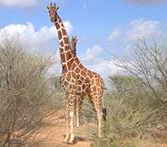African
wild dogs are vulnerable to extinction because they exist at
low densities, range widely, and come increasingly into contact
with people. Even wild dogs in protected areas frequently move
into adjacent areas where people live. Grassroots conservation
efforts beyond park boundaries are critical to prevent their
extinction. Rangelands
comprise about 85% of the land surface area in Kenya, and are
largely inhabited by pastoralists dependent on livestock. Wild
dogs and other carnivores co-habit these areas. The African
Wild Dog Conservancy has a community conservation project in
northeastern and coastal Kenya, a biodiversity rich mosaic of
protected areas and community lands under extreme threat. Due
to past and present security concerns, however, little is known
about the many threatened
species
that live here. This region is an important refuge for wild
dogs and an important corridor
for the metapopulation
in the Horn of Africa. Outside of this project, virtually
nothing is known about the conservation status and ecology of
wild dogs that live here. This project has been identified as
a conservation priority by the IUCN/SSC Canid Specialist Group
and the AZA/Wild Dog Species Survival Program.
|
|
|
|
|
|
|
| |
Kenya
(in yellow) straddles the equator and is surrounded by
neighbors. Rich in biodiversity, the country is challenged
with balancing the needs of a growing population with
conserving habitat and wildlife.
| The
survey area consists of community lands, national
parks, and
national reserves, and lies within two
biodiversity
hotspots: the Horn
of Africa and coastal
forests of East Africa.
|
This
satellite image of the survey area (the vertical green
line), includes Kenya's longest river, the Tana.
The river is the major perennial water source, with
flood waters feeding nearby swamps.
|
|
This
project investigates the ecology and effects of human activities,
cultural beliefs, and traditional practices on wild dogs in
this region by:
-
Collecting
and analyzing data on abundance and distribution, and
prey preferences with special reference to domestic livestock
-
Training
local people
-
Conducting
a trend survey of local attitudes and concerns about wild
dogs in particular, and carnivores in general
-
Identifying
and prioritizing threats to wild dogs
-
Developing a wildlife conservation education program
|
|
|
|
 |
|
|
| |
|
|
|
|
|
|
|
|
|
|
|
|
|
| |
|
|
|
Bob
teaching data entry |
|
|
Wild Dogs in the Biodiversity Hotspot Convergence
Zone
The
African Wild Dog Conservancy is presenting new information
on wild dogs in the biodiversity
hotspot convergence zone
that will be used for conservation planning. This
is part of a larger continent-wide planning effort
to help protect wild dogs and other carnivores.
What
Local People Say
The
first social survey of attitudes towards wild dogs
and other large predators has been completed with
over 200 villages participating and over
5,000 wild dog sightings.
Attitudes towards wild dogs and other predators
are largely negative because of concern for livestock
and personal safety. Despite this, wild dogs co-exist
with villagers with almost half of those interviewed
saying they wouldn't kill them.
Interestingly,
the majority of those interviewed didn't think predators
had any value, but didn't want them to become extinct.
Some villagers said they should be left alone. Reasons
given by those who thought that predators had value
included being an important part of their natural
heritage, having potential economic importance,
and consuming dead livestock. Many villagers qualified
their responses, indicating that predators should
be placed in a sanctuary or zoo, and only those
animals that kill livestock should be eliminated.
Although
the role of predators in the ecosystem wasn't well
understood, with over half of those surveyed believing
that wildlife couldn't become extinct, most expressed
concern for wildlife in general and the environment.
This belief highlighted the importance of working
with local people to address a key question "How
can wild dogs and people co-exist for future generations?"
Predators
and Livestock
Wild
dogs weren't considered a major cause of livestock
losses.
Spotted hyenas were far more likely to be blamed.
Losses to lions and leopards varied regionally,
while losses to hyenas, caracals, cheetahs, and
jackals were found in all villages surveyed. Pythons
and crocodiles occasionally took livestock as well.
|
| |
| |